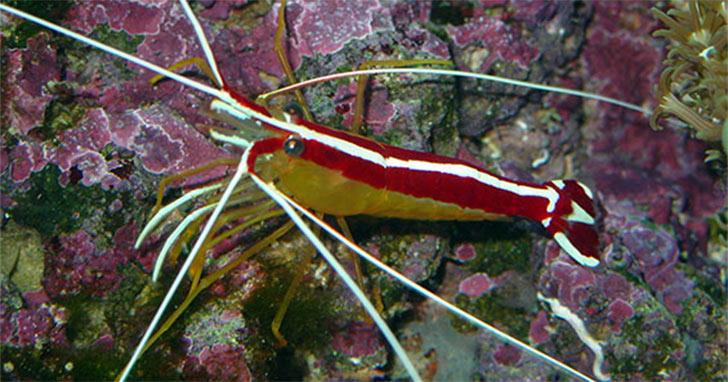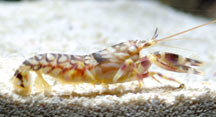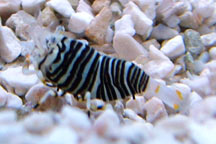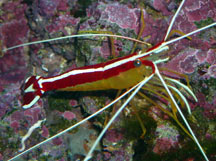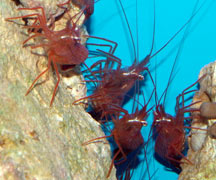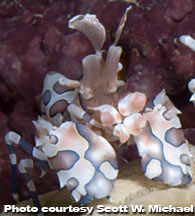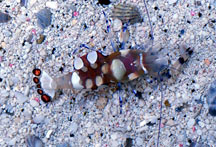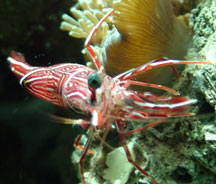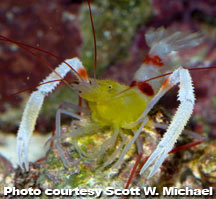Aquarium Shrimps - Shrimps in the Aquarium Trade
By Scott W. Michael
The shrimps that are most often encountered by aquarium keepers belong to the families Alpheidae (snapping shrimps), Gnathophyllidae (bumblebee shrimps), Hippolytidae (cleaner shrimps), Hymenoceridae (harlequin shrimps), Palaemonidae (commensal shrimps), Rhynchocinetidae (hingebeak shrimp) and Stenopodidae (boxer shrimps). Let's take a brief look at each of these families.
Alpheidae (Snapping Shrimps) The sand-dwelling snapping shrimps create their own burrows. Some of these form unique partnerships with certain gobies. These shrimps are vulnerable to being attacked by predators as they push sand and debris out of the entrance of their burrows. Their goby partners act as sentinels, warning the crustaceans of impending danger. The shrimp will typically place an antennae on the tail section of the fish. When the goby detects a potential threat, it will wag its tail to warn its crustacean burrow mate. These snapping shrimp-goby pairs make for a unique and interesting display in the home aquarium. If you want to keep a snapping shrimp-goby pair, you should purchase the animals together to ensure you obtain animals that will form a mutual bond. Fortunately, LiveAquaria.com often sells a goby or pair of gobies with the appropriate shrimp partner. Some snapping shrimps that end-up in the home aquarium are introduced inadvertently. These individuals are added along with live rock or stony coral colonies and are often heard (snapping) but never seen. The snapping shrimps, especially the burrowing forms, can provide an important function in the reef aquarium by turning and stirring the substrate. But this can also be problematic - if rock work is not suitably placed on the aquarium bottom their digging activity may cause cave-ins. This can be prevented by putting rock directly on the glass bottom and adding the sand around the rocks. Some burrowing snapping shrimp will battle each other for territory, unless they are of the same sex, then they will often share a burrow. The larger alpheids may prey on smaller shrimps or more diminutive, bottom-dwelling fishes. There are reports of snapping shrimps killing and eating their goby associate, when the latter were emaciated or ailing, but this rarely occurs.
Because they tend to spend most of their time hiding, the bumblebee shrimps do not make very good display animals. You may be able to observe them at night if you use a red incandescent or fluorescent bulbs over the aquarium. The bumblebee shrimps are also best kept in small aquariums (e.g., nano-reef), which will enable you to better relocate and observe them.
Hippolytidae (Cleaner Shrimps) The most popular members of the cleaning guild, and possibly of all the shrimps, are the members of the genus Lysmata. The Scarlet Cleaner Shrimp (Lysmata amboinensis) is ubiquitous in the trade and makes a wonderful aquarium resident, while the fire or Blood Red Shrimp (Lysmata debelius) is one of the most beautiful of all the aquarium shrimps. The Lysmata spp. tend to be quite hardy and sometime even reproduce in home aquariums. While the cleaning activities of these shrimps may provide some benefit to captive fishes, they will not eliminate parasite infections from their home aquarium. That said, they may reduce the number of trophonts (the ich "spots") on an infected fish.
Members of the genus Saron, which are sometimes referred to as marble shrimp, are not cleaners. They are reclusive during the day, hiding in reef nooks and crannies. At night, they move onto adjacent reef areas to graze on sessile invertebrates and detritus. There are a number of Saron spp. that are still undescribed. The two most common species in the aquarium trade are the Pinecone Marble Shrimp (Saron inermis) and the Common Marbled Shrimp (S. marmoratus). There are some hyppolytid shrimps that live in sea anemones (Sexy Shrimp, Thor amboinensis), soft corals (Soft Coral Shrimp, Hippolyte commensalis) or black corals (Saw Blade Shrimp, Tozeuma armatum). Some are also found in sea grass meadows or among macroalgae. These are some of the most highly desirable and durable of the aquarium shrimps. Most can be kept with members of their own species, or with other shrimps. In fact, they often do best when housed in pairs or groups. The fact that these crustaceans will clean makes them interesting to watch as well as beneficial to fish residents. The hyppolytid shrimps can live for up to three years in captivity.
Hymenoceridae (Harlequin Shrimps) What is particularly interesting about the Hymenocera spp. is that they feed on sea stars. A pair of these beautiful beasties (the adults are almost always found in pairs) will drag sea stars to their lair or incapacitate them where they find them. An observant friend of mine, Ray Izumi, has observed that these shrimps will vigorously stab their sea star prey with the spike-like end of one pair of legs. It may be that the shrimp are puncturing the water vascular system of the sea star so that it cannot move off. In this way, they would be able to control some of the large asteroids that they typically feed on. Their feeding behavior is somewhat Hannibal Lector-like. When they consume sea stars, they usually flip them over and begin feeding at the end of the arms, working their way toward the central disc. In this way, they can keep their "living buffet" fresh longer. In some cases, the shrimp will amputate an arm and let the rest of the sea star escape. Although it depends on the size of their echinoderm prey, the harlequin shrimp will take several days to several weeks to consume an entire sea star. They prefer sea stars in the genera Fromia, Linckia, and Nardoa, but will eat other species as well (including the crown-of-thorns sea star, Acanthaster planci). In the aquarium, they will also feed on sea urchins and brittle sea stars. Reef aquarists have been known to add one or a pair of these shrimps to a reef tank to deal with populations of Asterina sea stars. If you do this, make sure you are ready to provide larger sea stars once the Asterina run out. If you are willing to supply these shrimp with sea stars, they will thrive in the home aquarium. Harlequin Shrimp will even spawn in captivity.
Palaemonidae (Commensal Shrimps) There are members of this family, like some of the anemone shrimps, that engage in cleaning behavior. Potential fish clients will "park" or hover near an anemone occupied by displaying shrimps (they whip their antennae and chelae to-and-fro), at which time one or more of these crustaceans will leap onto the fish and pick at its skin, gills and even within the mouth. This family includes some species that are commonly encountered in the aquarium trade. They tend to be smaller and delicate shrimps that are preyed on by a large number of different reef fishes. Those that clean, may derive some degree of immunity from predators (at least those piscine hosts that utilize their cleaning services). At least some of the smaller anemone-dwelling forms (e.g., Periclimenes holthuisi) tend to occur in groups. These species will do best if kept in pairs or in small aggregations with a suitable host sea anemone.
Rhynchocinetidae (Hingebeak Shrimp) There are several species in this genus that regularly make it into the aquarium trade. The most common being the camel shrimp. It is an inexpensive species that makes an interesting display animal, especially when kept in groups (solitary individuals often do poorly in the aquarium).
Stenopodidae (Boxer Shrimps) The boxer shrimps are usually found in crevices or caves, they often hang from ceilings. Some species regularly share their hiding places with moray eels, which the shrimps groom (they apparently feed on the eels' body slime and parasites). They may also clean other fishes, rubbing their long antennae against a potential client's body to induce posing. The Stenopus spp. are usually found in pairs and apparently form these bonds when they are quite small. The male is reported to do the foraging and will even bring food to its mate. Pair members have even been observed to defend their molting mates! Although somewhat retiring, the boxer shrimps make great display animals. They are hardy, feeding on any food that hits the substrate. The aquarist should be aware that large boxer shrimps have been known to capture and kill small fishes (e.g., nano gobies). They will either grab them when they move past or catch them at night when these fishes are torpid. These are fast growing shrimps that molt frequently.
 Scott Michael
Scott MichaelScott W. Michael is an internationally-recognized writer, underwater photographer, and marine biology researcher specializing in reef fishes, and was the Banquet Speaker at our 2007 and 2008 Coral Conference and Frag Swap. He is a regular contributor to Aquarium Fish Magazine, Freshwater and Marine Aquarium Magazine, SeaScope, and is the author of Reef Fishes Vol 1, Vol 2, and Vol 3, Vol 4, and Vol 5., A Pocket Expert Guide Marine Fishes, A Pocket Expert Guide to Reef Aquarium Fishes, 101 Best Saltwater Fishes: How to Choose and Keep Hardy, Brilliant, Fascinating Species That Will Thrive in Your Home Aquarium, Reef Sharks & Rays of the World, and Aquarium Sharks & Rays. Having studied marine biology at the University of Nebraska, Scott has served as a scientific consultant for National Geographic Explorer, the Discovery Channel, and French educational television. Resources Debelius, H. 1999. Crustacea Guide of the World. IKAN, Frankfurt, Germany, 321 Pp. Fossa, S. A. and A. J. Nilsen. 2000. The Modern Reef Aquarium. Volume 3. Birgit Schmettkamp Verlag, Bornheim, Germany, 448 Pp. Hoover, J. P. Hawaii's Sea Creatures. Mutual Publishing, Honolulu, Hawaii, 366 Pp. |
||||||
|
|



